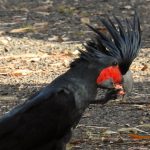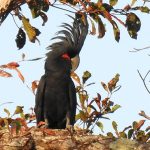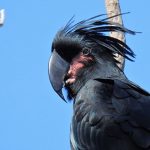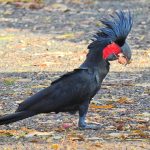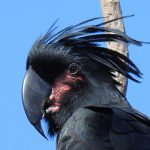PALM COCKATOO
The Palm cockatoo is one of the largest species of cockatoos, with males reaching a length of about 55 to 60 cm and females slightly smaller. It has a unique appearance with a large black body, dark grey feet, and a massive black beak that is proportionally larger than that of other cockatoo species. The cheeks and the area around the eyes are adorned with a striking red patch, making it easily distinguishable.
Palm cockatoos are known for their impressive vocal abilities. They have a diverse range of calls and are particularly well-known for their drumming behaviour. Using sticks or seedpods, they rhythmically beat them against hollow tree branches, creating loud drumming sounds that can be heard over long distances. This behaviour is believed to be part of courtship and territorial displays.
Palm cockatoos are generally solitary birds and are often seen in pairs or small family groups. They are highly intelligent and exhibit complex problem-solving abilities. They use their powerful beaks to crack open hard nuts and seeds, and they also feed on fruits, berries, and other plant material found in their rainforest habitat.
Palm cockatoos are monogamous and form long-term pair bonds. During courtship, they engage in elaborate displays, including drumming and vocalizations. The female typically lays one or two eggs in a tree hollow, where she incubates them. Both parents participate in raising and caring for the chicks.
The palm cockatoo is still relatively common in Cape York, but is threatened there by habitat destruction, particularly due to bauxite mining around Weipa and altered fire regimens elsewhere. It is listed as vulnerable by the International Union for Conservation of Nature (IUCN) due to loss of habitat and illegal pet trade.
The palm cockatoo’s unique appearance, vocal abilities, and behaviours make it a fascinating species to study and appreciate in the wild. Efforts to protect their rainforest habitat and combat illegal wildlife trade are crucial for the long-term survival of this magnificent bird.

